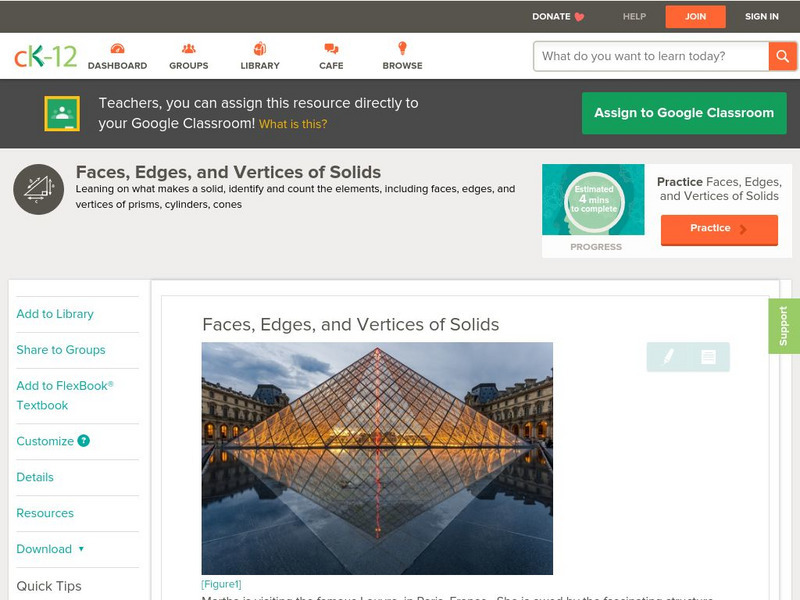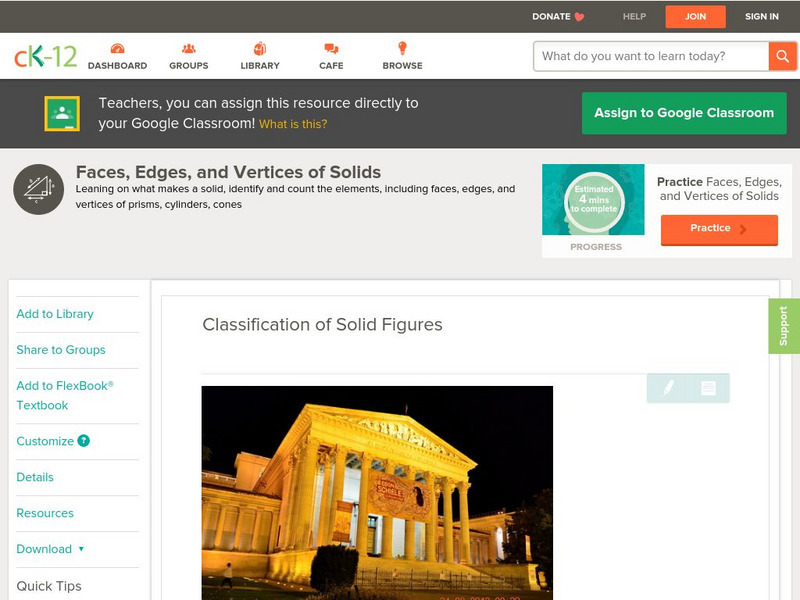Hi, what do you want to do?
Curated OER
Surface Area of Rectagular Prisms
Sixth graders investigate the area of polygons. In this geometry lesson, 6th graders calculate area of prisms using geometric formulas. They work with prisms and other rectangular shapes.
Curated OER
The X-33 and the X-38
Students explore the relationships among the lengths, areas, and volumes of similar solids. They also discover what effect doubling the dimensions of a figure has on the resulting area.
Curated OER
Cross Sections
Young visual learners explore different cross sections of 3-dimensional objects. First, cross sections of cubes are explored by using an interactive flash activity. This is then extended by looking at cross sections of spheres,...
Curated OER
Octahedron
In this math worksheet, students develop cognitive and geometric abilities. They construct a paper model of a octahedron composed of eight triangular faces, six vertices and 12 edges.
Curated OER
City Streets: A Fold-up of a Street Lined with Buildings
After walking in a nearby neighborhood, have your class create this amazing city street pop-up. They study the facades of the buildings they see, focusing on geometric line, shape, and architecture. They then draw, cut, and create a city...
Curated OER
Supplementary, Complementary, and Vertical Angles
By using circles that they cut out and label themselves, learners literally "get a grip" on the angles they identify: supplementary, complementary, and vertical. They solve missing measurements based on properties of supplementary,...
Curated OER
Math in the Wetlands Field Trip
Get your class out in the environment for hands on math activities. In this wetlands lesson, learners transplant native plants, calculate how much soil is needed, and perform math activities based on this experience. They then make...
Curated OER
Modeling the Solar System
Students build a scaled model of the solar system. In this space science activity, students arrange them according to their distances from the sun. They analyze each planet's unique features such as density and relative gravity.
Curated OER
Measurement
Middle schoolers create two prisms out of the same paper. They calcuate the number of centimeter cubes needed to fill each prism. They discover the concept of volume.
Curated OER
Volume and Surface Area
Learners explore volume and surface area. In this math lesson plan, students fill boxes with cubes to identify the volume of the boxes. Learners discuss area.
Curated OER
Analyzing 3-D Shapes and 2-D Representations
Students can analyze 3-D objects better with actual physical models and by also drawing 2-D representations of them.
Curated OER
A World of Symmetry
Middle schoolers identify lines of symmetry. In this symmetry lesson, students create objects and identify their lines of symmetry. They answer questions about lines of symmetry. Middle schoolers cut shapes out of...
Curated OER
How Many?
In this measurement worksheet, students complete a 12 question multiple choice online interactive assessment about standard modern and ancient measurement.
Curated OER
Polygons and Plane Figures
Young scholars choose a polygon to define and describe, and use Power Point and the Internet to present their polygon.
Curated OER
Classify Prisms
Students classify prisms according to their attributes. In this classifying prisms lesson, students explore different prisms. Students generate observations of the attributes and classify the prism correctly.
Curated OER
Classifying Pyramids
Students study pyramids. In this prisms lesson plan, students explore the attributes of pyramids. Students will explore the lateral surface area of pyramids and be able to distinguish pyramids from other space shapes.
Curated OER
Three-Dimensional Figures
Sixth graders explore three-dimensional objects. Using various objects found in the classroom, they identify faces, edges, and vertices of objects. Students create their own objects. They describe the polydron, telling the faces,...
Curated OER
Mineralogy, Astronomy, & Ancient Wisdom
Students complete a variety of activities surrounding minerals, crystals, and mineralogy. They locate common minerals on a world map, complete a lab in which they identify the chemical and physical properties of various minerals, etc.
Curated OER
Checking County Numbers
Students use their county's information page to gather information about their community. Using the information, they create graphs from the tables provided and interpret the data. They write a paragraph showing their interpretation of...
Cuemath
Cuemath: Solid Shapes
Explore the world of solid shapes in this mini-lesson. Provides a definition, interactive examples, and interesting practice questions that help with understanding.
CK-12 Foundation
Ck 12: Geometry: Faces, Edges, and Vertices of Solids
[Free Registration/Login may be required to access all resource tools.] In this lesson students identify and describe the faces, edges and vertices of solid figures. Students examine guided notes, review guided practice, watch...
CK-12 Foundation
Ck 12: Geometry: Classification of Solid Figures
[Free Registration/Login may be required to access all resource tools.] In this lesson students learn to classify solid figures by using faces, edges and vertices. Students examine guided notes, review guided practice, watch...
CK-12 Foundation
Ck 12: Geometry: Classification of Solid Figures
[Free Registration/Login may be required to access all resource tools.] In this lesson students classify different types of solid figures. Students examine guided notes, review guided practice, watch instructional videos and attempt...
CK-12 Foundation
Ck 12: Geometry: Cross Sections and Nets
[Free Registration/Login may be required to access all resource tools.] In this lesson students draw two-dimensional representations of solid figures. Students examine guided notes, review guided practice, watch instructional videos and...
Other popular searches
- Solid Geometry Nets
- Math, Solid Geometry
- Solid Geometry Formula
- Solid Geometry Volume
- Solid Geometry Rubric
- Solid Geometry Figures
- What Is Solid Geometry
- Art and Solid Geometry
- Solid Geometry and Volume
- Solid Geometry Bubbles
- Math Solid Geometry
- Solid Geometry Introduction




























